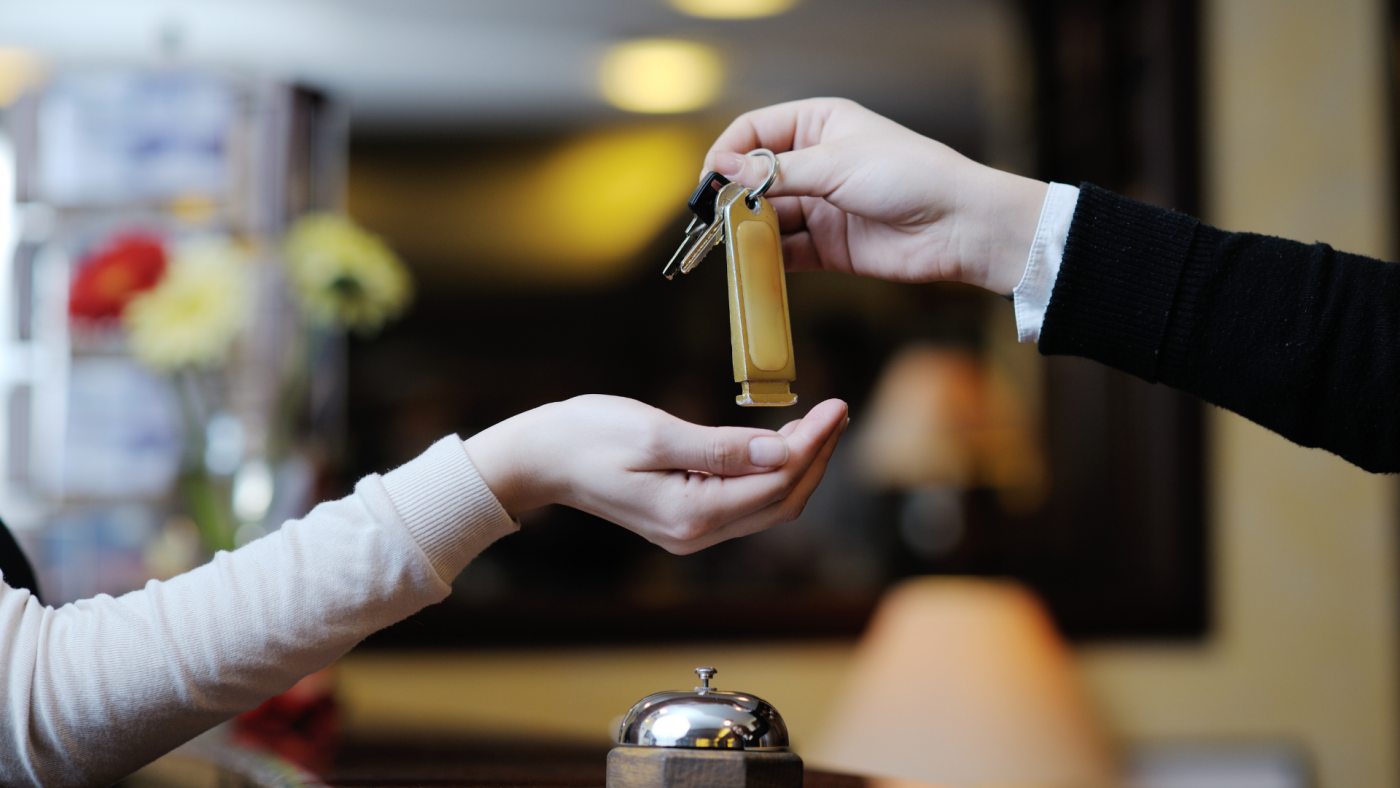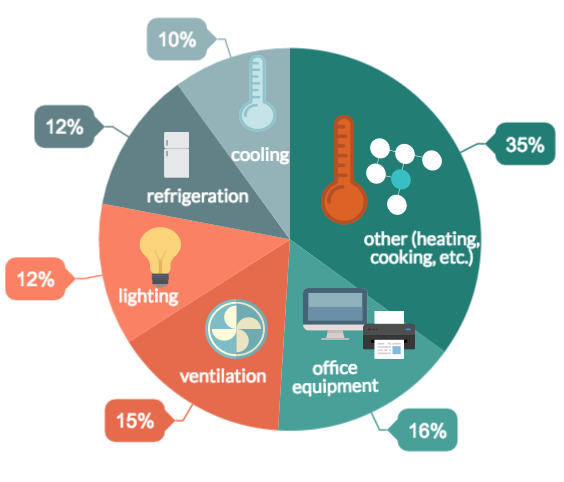Did you know that 60% of your hotel’s carbon footprint comes from energy use? Not only that, but your bottom line is affected too: energy use is eating up 6-10% of your property’s revenues. It might not be your biggest operating cost – but it’s the one growing fastest! Besides, when it’s so easy to do a little hotel energy management, what hotelier wouldn’t want to save money on their next electricity bill?
Plus, your customers want greener hotels – but they aren’t necessarily willing to sacrifice higher rates or forgo any kind of luxury. If you are in the hospitality industry, read on to learn how to balance an optimal guest experience with properly implemented hotel energy management:
Like most tertiary sectors, the hospitality industry is undergoing a huge transformation, both green and digital, to meet changing customer demands. A recent E.ON survey of 2,000 guests found that 50% prefer a sustainable stay – all while admitting to using more energy than ever.
Is there a way to balance such opposed customer demands? In our experience, the devil is in the data – meaning the answer may well be found in using energy analytics to satisfy both ends of the guest experience spectrum. But first things first: we need to know what your hotel energy consumption looks like…
How do Hotels use Energy?
Typically, energy consumption accounts for up to 10% of the total operating costs of hotels, and 60% of your property’s carbon footprint.
To give you a general idea of how that energy is consumed, let’s take a look at the consumption breakdown for the average full-service facility which consumes 14 kWh per square foot annually.
The main takeaway is to sweat the small stuff – it adds up! Miscellaneous uses such as heating, cooking, water heating and others consume nearly half of all the energy in your hotel. After that, office equipment, ventilation and lighting are the primary consumers of electricity overall.
Energy use in Hotels:
3 Steps to optimise Hotel Energy Management
Of course, not all hotels are created equal, and luxury establishments or huge all-inclusive resorts will naturally require more energy than a small countryside B&B. Although no silver bullet solution exists to guarantee energy efficiency for every hotel, certain actions can be taken depending on your property’s characteristics and management’s willingness to implement changes. Before you start, it helps to obtain some kind of diagnostic report, sometimes known as an energy audit.
1. Find out if you are overpaying for your Energy
On-site energy audits can be very costly, and most smaller hoteliers usually lack the means to spend time or budget on energy efficiency measures in the first place.
The perfect solution to this conundrum is Dexma Detect – a fast virtual energy audit tool that not only shows if you are paying too much for your energy but also calculates your hotel’s energy savings potential.
By anonymously comparing the electricity consumption of your property with data from similar buildings in your area, hoteliers can understand how much electricity and money their facility can save.
After crunching some data from existing Dexma Detect reports, our Product Team discovered that on average, hotels can generate up to 40% in potential energy savings – and that’s just for electricity! (Don’t forget about gas and thermal sources – water heating is a huge energy vampire in hotels. More about those here.)
2. 10 ways to Cut that low-hanging fruit
Armed with DEXMA Detect, it’s time to start taking steps to cut your consumption. Here are 10 zero-cost actions to get started on your hotel energy management journey:
- Walk around your hotel at different times of the day and note which lights could be turned off without any impact. If switching off completely in unoccupied hallways is impossible, dimming is your next-best option. Try to dim artificial light by 30% wherever you see natural light.
- Book rooms in clusters to boost the overall energy efficiency of your hotel, preferably starting with lower floors. Corner rooms, as well as ones on upper floors, are more energy intensive for heating, so try to leave them for last.
- During winter, book more rooms on the sun-facing side, to reduce the need for heating, and do the opposite during the summer.
- Try not to operate heating and cooling systems at the same time – a common mistake in hotels. When the external temperature reaches 21°C, turn off the heating. Don’t use the AC until the external temperature exceeds 23-24°C.
- Avoid overheating low circulation areas. During late hours, the lobby doesn’t need to be as well-lit or heated as during busy hours. The same goes for staff circulation areas, such as laundry rooms or kitchens, especially during off hours:
Hotel Energy Management: Energy Efficient Temperature by Room Type
- In addition to lowering ambient room temperature, reduce the temperature of the water used for laundry services. Aim for 60°C as it provides comfort while staying hot enough to kill legionella bacteria.
- Train kitchen staff to reduce pre-heating time to 15 minutes before the appliance is needed. This can save up to 60% of the energy used in cooking!
- Find a way to cover the pool when unused – this can reduce energy lost through evaporation by 50 to 70%. It also reduces the flow of makeup water and the need for additional chemical treatments.
- Turn off saunas and steam rooms when not in use – best done with an auto-timer.
- Invite both guests and staff to report any areas that are too hot, cold or draughty – and resolve those requests promptly! This is a great chance to improve the guest experience while saving energy and money. Triple whammy!
3. Consider recommisioning your hotel
One option that dramatically increases hotel energy efficiency is called recommissioning. Think of it like “tuning” your building so that it works as efficiently as possible. 10 to 15% of hotel energy consumption can be cut by this process without sacrificing any of your guests’ comfort. Ideally, a hotel should get recommissioned at least once every five years. This involves a lot of on-site energy auditing, and sometimes even construction work – so it’s a good idea to see if it’s worth it first. With virtual audit tools like Dexma Detect, you can do that.
If you’re even more serious about making your establishment as eco-friendly as possible, it’s worth considering a full retrofit, especially for older properties. Here are two technologies to consider:
- Energy-efficient lighting technology should be used wherever possible. Install daylight and occupancy sensors and low-energy lighting wherever possible. Replace tungsten GLS lightbulbs and T12 fluorescent tubes with T5 tubes, or LED lamps. This can reduce lighting energy consumption by up to 80%. Plus, you’ll save money as efficient lamps last more than 8 times longer, produce less heat, and require less cooling.
- Combined heat and power (CHP) is the simultaneous generation of heat and power from one fuel, usually on-site or near your hotel. Heat is recovered on-site and can be used to warm rooms, do laundry, operate showers and sterilise equipment – making it an efficient choice for energy-smart hotels. One 400-room luxury hotel in the UK installed a CHP system that provided annual savings of more than £50,000 and reduced carbon dioxide emissions by 1,000 tonnes per year. In another medium-sized hotel, the CHP system achieved a savings of £7,000 per year and delivered an ROI in less than five years.
Perhaps you are planning to build an entirely new property and want to make it eco-efficient as possible. Why not start by learning the best hotel energy management practices from the greenest hotel in the UK? Check out their story here.





